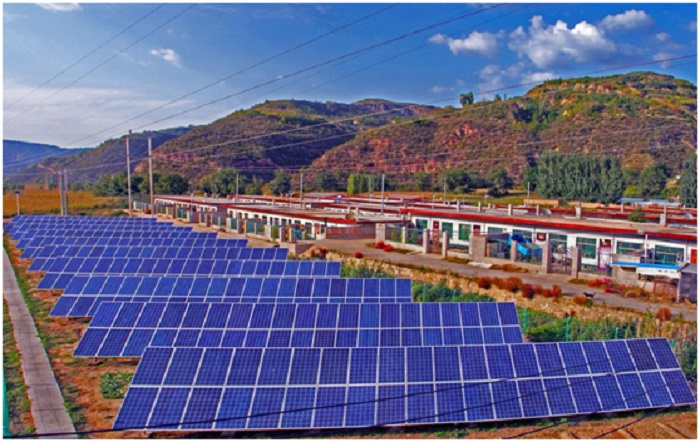



Photovoltaic (PV) power stations in north China’s Shanxi province have not only helped free all the poor population of the province from poverty, but made Shanxi one of the most successful provinces in China in terms of income from PV power generation and profits received by villages from PV power projects last year.
Covering all the previous impoverished counties and villages in Shanxi province, PV power stations represent the largest poverty alleviation program of the province. As of the end of 2020, the installed capacity of PV power stations across the province reached 2.94 million kW, while the number and installed capacity of village-level PV power stations hit 5,479 and 1.55 million kW respectively.
“PV projects bring better life to me.” The remark by local people reflects their heartfelt gratitude for PV power stations built to help them get rid of poverty.
Erji village in Daning county of Shanxi province is well known for developing PV power projects.
Since it piloted PV power stations in 2014, Erji has transformed from a poor village without collective economy into one that enjoys an average annual collective income of about 300,000 yuan ($46,440) from PV projects, said Xu Yusheng, secretary of Communist Party of China (CPC) branch in Erji village.
With the collective income, the village created various public-service jobs, including sanitation worker, security guard, e-commerce service staff, and village doctor, for poor people, in a bid to help them increase income through work.
Small public welfare undertakings have also thrived in Erji village following the victory of local people over poverty. With smoother roads, pruned trees, renovated squares and other great changes, the village is seeing more and more pleasant living environment with each passing day.
“I’ve benefited so much from these favorable policies,” Ma Yue’en, a villager in his eighties told People’s Daily happily. Since PV power stations were introduced into the village, Ma has not only enjoyed old-age pension from the government, but received free chemical fertilizers from the village.
To encourage people to support their ageing parents, Erji village stipulated that the village adds 200 yuan to every 1,000 yuan of living expenses children give to their parents.
In an effort to help people suffering from extreme poverty, Shanxi province channeled more PV projects into counties and villages in extreme poverty, according to Zhang Linyang, an official from Shanxi Poverty Alleviation and Development Office.
Forty three percent of the poverty alleviation PV projects in Shanxi province are located in ten counties that suffered from extreme poverty, Zhang noted.
Because of poverty alleviation projects, Linxian county, which used to be the largest impoverished county in Shanxi province, has witnessed tremendous changes.
In Baiwen township of Linxian county, impressive PV power stations covering an area of about 80 hectares look just like the vast blue ocean from a distance.
The “blue ocean” can generate 44 million kWh of electricity per year, benefiting people in six villages of Baiwen township with an annual income of around 37 million yuan.
To make the most of resources, local people have also grown medicinal herbs like rhizoma anemarrhenae and Chinese ground orchid (Bletilla striata) under the PV panels of the power stations.
With a typical landform of loess plateau, Linxian County is crisscrossed with ravines and gullies. To conserve land, the county built PV power stations in one specific location according to local conditions.
The PV power stations have helped increase the income of 4,997 poor households in 53 poor villages by offering them multiple sources of income, including rental income from land occupied by power stations, wages from planting medicinal herbs, as well as money from secondary distribution of collective income of their villages, according to Gao Zerong, a member of the standing committee of CPC Linxian county committee.
PV projects have played a significant role in fighting poverty in and consolidating poverty alleviation results of Linxian county, which used to feature large poor population and high incidence of poverty, Gao pointed out.
“Now that we don’t need to worry about our livelihood, villagers have a stronger sense of happiness,” said Wang Xiaolan, a woman in Kangjiawan village, Muguaping township of Linxian county.
Wang and her husband have both taken public-service jobs offered by her village, which can ensure a combined annual income of over 200,00 yuan for their family, Wang told People’s Daily.
Kangjiawan village has also opened daycare center for the elderly who live alone, Wang said, explaining that these people can enjoy free meals and laundry service at the center, and the expenditure of the center is covered by income from the local PV power stations.
By the end of 2020, Shanxi province had gained an income of 3.61 billion yuan from poverty alleviation PV power projects, according to reliable data, which also showed that over 3.26 billion yuan of the income went to 9,965 villages in the province.
In 2020 alone, the province saw an income of 1.96 billion yuan from its PV projects, which serves as a pillar of Shanxi in securing the final victory over poverty and offsetting the impacts of the COVID-19 pandemic.
To make sure all the income from the PV power stations is used for the people, Shanxi became the first province in China to create an income distribution management system for poverty alleviation PV projects, according to Zhang, who explained that the system enables various counties and villages to upload relevant information in a real-time manner to guarantee fair and transparent distribution of income.
Moreover, Shanxi province has connected all of its PV power stations to China’s national PV poverty alleviation information monitoring system, in a bid to supervise the operation of PV power stations at any time, Zhang noted.


Senator Chuka Utazi who represented Enugu.


An Abuja based Legal Practitioner, Ugochukwu.


The African business community in Yiwu,.


Anti – kidnapping, Human Trafficking, Child.


The All Farmers’ Association of Nigeria.


The police on Tuesday arraigned a.


As part of measures to further.


Presidential Support C’ttee hails Ganduje’s emergence.


In response to the impact of.
A prayer group in Nigeria under.
Leave a Comment